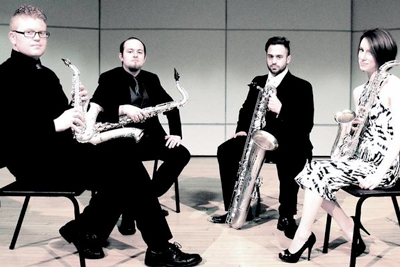by Mike Telin

“We keep finding ourselves back in Cleveland. It’s become like a second home to us,” Swanson said during a recent telephone conversation. “We’re very excited about this program. It’s a lot of fun, and it celebrates the early tradition of our instruments.” The concerts will include the first work ever written for saxophone quartet, Jean Baptiste Singelée’s Premier Quaturo, Op. 53, and another early work for sax quartet by American composer Caryl Florio. The program will also include works by Dan Knorr, Philip Glass, and J.S. Bach.
Adolph Sax was born on November 6, 1814 in Dinant, Belgium. “He later relocated to Paris, and in addition to the inventing the saxophone, he developed the modern tuba, euphonium, and the bass clarinet,” Swanson pointed out. “His contributions to the music community are endless, but the saxophone is his crown jewel.” Swanson went on to say that composer Jean-Baptiste Singelée was a childhood friend of Sax, who also had moved to Paris. “In 1857 he wrote a full-scale Romantic sax quartet that included a part for tenor saxophone, which had not yet been invented, so he wrote it assuming that his good friend Adolph Sax would finish the instruments soon. Premier Quatuor is in five movements, and twenty minutes in length. It’s the first saxophone quartet ever to be written, and it was performed during Sax’s lifetime.”
Another work on the program from the Romantic period is a quartet written in 1879 by the American composer Caryl Florio. “Quartette was written for the ‘New Wonder Saxophone Quartet,’ which was based in New York City. This is his most famous work because for so long there was a very limited repertoire for the ensemble, so the piece was performed more than anything else he had written. Florio was an interesting guy. He was born William James Robjohn but he changed his name to Caryl Florio because his well-to-do family were rather embarrassed by his musical career. He was the music director at Wells College, as well as a teacher and a critic.”
Swanson looks forward to introducing audiences to the music of Rochester-based composer Dan Knorr. “I cannot say enough good things about Knorr’s quartet. He’s an outstanding composer, and his music has started to take hold in the contemporary classical scene. In my opinion, his saxophone quartet is one of the most significant contributions to the repertoire in the last half decade. It was written in 2012, and has been played several times by various ensembles. It’s a five-movement work in which all of the themes return in that final movement. It’s musically fascinating, and a very strong piece.”
The concerts will conclude with a staple of the sax quartet repertoire by Philip Glass. “His Concerto for Saxophone Quartet was written in 1995 for the Rascher Saxophone Quartet, and as the title implies, it is to be played with an orchestra. But Glass wrote it in two ways, as quartet with chamber orchestra, and one where all of the parts are distilled into the quartet, which is the version we will be performing. It’s a great work. The first and third movements are very hypnotic, and the second and fourth movements are just fast and raucous. It’s exciting music.”
Has the sound of the saxophone changed since Sax’s day? “We’ll be performing the concerts on historically accurate instruments, and it’s going to make for a unique listening experience,” Swanson said. “It’s a little like listening back in time, the way it would have been experienced 150 years ago.”
What about the instrument has changed? “The most significant difference is the mouthpiece, which over time has chanced quite a bit in order to create a more brasslike quality in the sound, in order to cut through in jazz and rock music. But that sound has become fairly well accepted in the classical world. But part of our mission is to broaden the saxophone in classical music, so we like to return to the original sound, which has a more warm, string-like quality. And we use early equipment to achieve that sound.”
How much early equipment is out there to be found? “Tons,” Swanson said. “There are modern replicas of the early instruments too. But yes, it is out there. We like to preserve the traditional sound, but also carry that sound forward with new music like Dan Knorr’s piece. We want the audience to experience the original concept of the instrument’s sound in today’s musical vocabulary. We’re excited about this quartet concert. The strength of the ensemble is that at our collective heart we’re always working to share the saxophone in any, and every way that we can.”
Published on ClevelandClassical.com July 14, 2015.
Click here for a printable copy of this article


